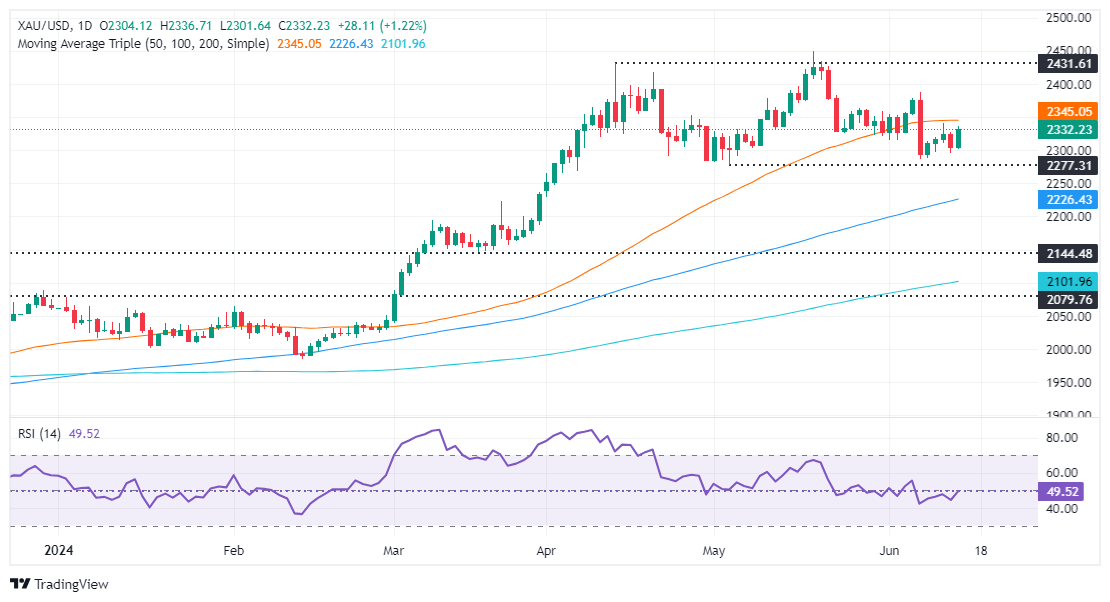- Gold soars above $2,330 as investors bet on Fed rate cuts later this year.
- Risk aversion due to European political turmoil boosts demand for safe-haven assets like gold.
- US Consumer Sentiment dips in June, inflation expectations remain above Fed’s 2% target.
- XAU/USD is underpinned by fall of 10-year US Treasury yield.
Gold’s price spiked during the North American session on Friday after inflation data in the United States (US) increased investors’ hopes of the Federal Reserve (Fed) cutting interest rates later this year. Additionally, risk aversion, spurred by Europe’s political uncertainty, triggered a flight to safety, bolstering the golden metal.
The XAU/USD trades at $2,333, gaining more than 1.30% after bouncing off daily lows of $2,301. Sentiment remains sour, yet US equities recovered some during the last hour of trading, with the Nasdaq up 0.28%, while the S&P 500 trims its earlier losses, shy of being flat on the day at -0.10%.
On the data front, US Consumer Sentiment deteriorated in June, while inflation expectations for one and five years remained above the Fed’s 2% goal. Meanwhile, US inflation data revealed during the week was cheered by investors, who still bet that the US central bank will slash rates twice instead of just once, as policymakers projected.
Data from the Chicago Board of Trade (CBOT) shows traders expect 39 basis points (bps) of easing during the year via December’s 2024 fed funds rate contract.
The US 10-year Treasury note yield dropped three bps to 4.211%, a tailwind for the non-yielding metal, shrugging off China’s bullion purchasing pause.
News that the People’s Bank of China paused its 18-month bullion buying spree weighed on the precious metal. PBOC holdings held steady at 72.80 million troy ounces of Gold in May.
Daily digest market movers: Gold price strengthens amid strong US Dollar
- US Dollar Index (DXY) increased by 0.28% to 105.53, capping Gold prices.
- University of Michigan Consumer Sentiment Index fell to 65.6 in June from 69.1, missing the consensus estimate of 72. This marks the lowest level of sentiment in seven months.
- Inflation expectations for the next twelve months are projected to remain unchanged at 3.3%; while for the five-year period, inflation expectations are anticipated to decrease to 3.1%, down from the previous 3.3%.
- On Wednesday, Fed Chair Jerome Powell stated that they are less confident about inflation than previously “in order to cut.” He added, “If jobs are to weaken unexpectedly, the Fed is ready to respond.” When asked about the US CPI report, Powell noted that it is just one report and emphasized the need to see the deflation process evolving toward the Fed’s goal.
- Despite US CPI report showing disinflation process continuing, Fed Chair Jerome Powell commented that they remain “less confident” about the progress on inflation.
- Even though the latest US CPI and PPI reports were weaker than expected, the latest NFIB Small Business Optimism Index survey for May showed that businesses are struggling with higher prices and access to cheap financing.
Technical analysis: Gold price sellers regain control as prices are headed toward $2,300
Gold price is neutral to downwardly biased as the Head-and-Shoulders chart pattern remains in place, suggesting the stage is set for further downside. Although momentum shows buyers’ recovery, the Relative Strength Index (RSI) remains bearish, suggesting that the uptrend could be short-lived and open the door for further losses.
If Gold extends its gains past the June 7 cycle high of $2,387, it will be ready to test the $2,400 figure. Conversely, if XAU/USD drops below $2,300, the first support would be the May 3 low of $2,277, followed by the March 21 high of $2,222. Further losses lie beneath, as sellers would eye the Head-and-Shoulders chart pattern objective at around $2,170 to $2,160.
Fed FAQs
Monetary policy in the US is shaped by the Federal Reserve (Fed). The Fed has two mandates: to achieve price stability and foster full employment. Its primary tool to achieve these goals is by adjusting interest rates. When prices are rising too quickly and inflation is above the Fed’s 2% target, it raises interest rates, increasing borrowing costs throughout the economy. This results in a stronger US Dollar (USD) as it makes the US a more attractive place for international investors to park their money. When inflation falls below 2% or the Unemployment Rate is too high, the Fed may lower interest rates to encourage borrowing, which weighs on the Greenback.
The Federal Reserve (Fed) holds eight policy meetings a year, where the Federal Open Market Committee (FOMC) assesses economic conditions and makes monetary policy decisions. The FOMC is attended by twelve Fed officials – the seven members of the Board of Governors, the president of the Federal Reserve Bank of New York, and four of the remaining eleven regional Reserve Bank presidents, who serve one-year terms on a rotating basis.
In extreme situations, the Federal Reserve may resort to a policy named Quantitative Easing (QE). QE is the process by which the Fed substantially increases the flow of credit in a stuck financial system. It is a non-standard policy measure used during crises or when inflation is extremely low. It was the Fed’s weapon of choice during the Great Financial Crisis in 2008. It involves the Fed printing more Dollars and using them to buy high grade bonds from financial institutions. QE usually weakens the US Dollar.
Quantitative tightening (QT) is the reverse process of QE, whereby the Federal Reserve stops buying bonds from financial institutions and does not reinvest the principal from the bonds it holds maturing, to purchase new bonds. It is usually positive for the value of the US Dollar.

